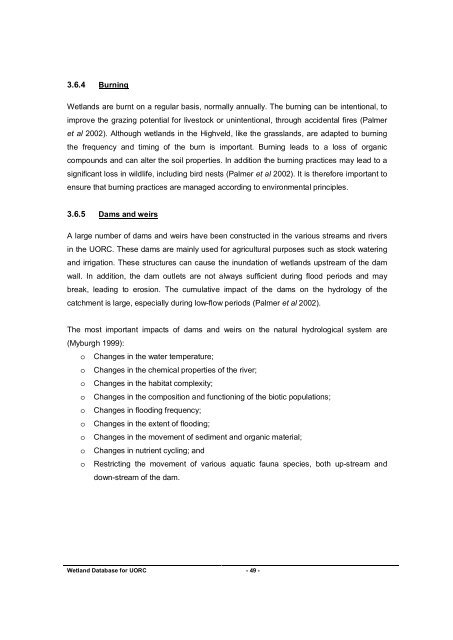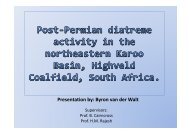coaltech upper olifants river catchment wetland inventory ...
coaltech upper olifants river catchment wetland inventory ...
coaltech upper olifants river catchment wetland inventory ...
You also want an ePaper? Increase the reach of your titles
YUMPU automatically turns print PDFs into web optimized ePapers that Google loves.
3.6.4 Burning<br />
Wetlands are burnt on a regular basis, normally annually. The burning can be intentional, to<br />
improve the grazing potential for livestock or unintentional, through accidental fires (Palmer<br />
et al 2002). Although <strong>wetland</strong>s in the Highveld, like the grasslands, are adapted to burning<br />
the frequency and timing of the burn is important. Burning leads to a loss of organic<br />
compounds and can alter the soil properties. In addition the burning practices may lead to a<br />
significant loss in wildlife, including bird nests (Palmer et al 2002). It is therefore important to<br />
ensure that burning practices are managed according to environmental principles.<br />
3.6.5 Dams and weirs<br />
A large number of dams and weirs have been constructed in the various streams and <strong>river</strong>s<br />
in the UORC. These dams are mainly used for agricultural purposes such as stock watering<br />
and irrigation. These structures can cause the inundation of <strong>wetland</strong>s upstream of the dam<br />
wall. In addition, the dam outlets are not always sufficient during flood periods and may<br />
break, leading to erosion. The cumulative impact of the dams on the hydrology of the<br />
<strong>catchment</strong> is large, especially during low-flow periods (Palmer et al 2002).<br />
The most important impacts of dams and weirs on the natural hydrological system are<br />
(Myburgh 1999):<br />
o Changes in the water temperature;<br />
o Changes in the chemical properties of the <strong>river</strong>;<br />
o Changes in the habitat complexity;<br />
o Changes in the composition and functioning of the biotic populations;<br />
o Changes in flooding frequency;<br />
o Changes in the extent of flooding;<br />
o Changes in the movement of sediment and organic material;<br />
o Changes in nutrient cycling; and<br />
o Restricting the movement of various aquatic fauna species, both up-stream and<br />
down-stream of the dam.<br />
Wetland Database for UORC - 49 -




